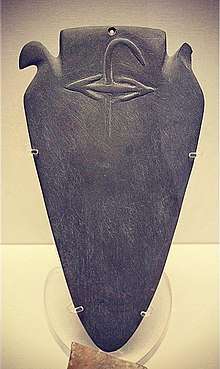Min Palette
The Min Palette, or El Amrah Palette is an ancient Egyptian cosmetic palette from El Amrah (for the Amratian Period), found in Naqada, tomb B62. It is held in the British Museum, no. 35501.[1]

Mudstone Min palette with hieroglyphs in relief. Late Predynastic, Naqada III. 3250-3100 BC. From El-Amra. The exact meaning of there early signs is unclear. The horizontal sign resembles that later used to write the name of the god Min.
Description
The Min Palette is a flat slate palette, unadorned, with no iconographic scenes.
Two topics are displayed on the palette. The Symbol of Min, a compound-type hieroglyph arrangement, is centered at the top of the palette, and comprises 1/4 of the palette's front. The other motifs are opposed-facing bird heads on each top corner; the heads are small, with a thin neck, about a tenth the height of the palette, and the right head is damaged.
A small suspension hole is centered on the palette's top.
Min's emblem
The Emblem of Min on the palette is a typographic ligature of two Egyptian hieroglyphs–
and
. The later horizontal form of the Min symbol (hieroglyph), (consisting of two opposing-faced arrows), is shown in an archaic form. Centered vertically overlaying the Min hieroglyph is a vertical "crook" or staff, the version of the 'straight staff', [2] (see Crook-staff (Luwian hieroglyph)).
See also
References
Further reading
- Betrò, Maria Carmela. Hieroglyphics: The Writings of Ancient Egypt, c. 1995, 1996-(English), Abbeville Press Publishers, New York, London, Paris (hardcover, ISBN 0-7892-0232-8)
External links
This article is issued from Wikipedia. The text is licensed under Creative Commons - Attribution - Sharealike. Additional terms may apply for the media files.